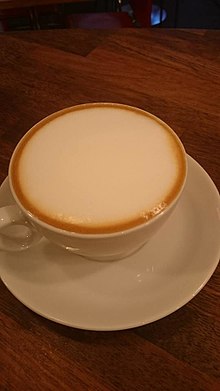Cappuccino
Cappuccino (Italian [ kap ː ː ut ʃi ː no], German [ ˌ kapʊtʃi ː no] ) is an Italian coffee drink prepared with espresso, hot milk and hot milk foam.
It is drunk usually served in thick-walled, pre-warmed cups of earthenware or porcelain and sweetened. In Italy it is taken almost exclusively for breakfast.
In Germany cappuccino has in recent years become one of the most popular coffee drinks. So drink 15.8 % of the Germans at least once a week a cappuccino.
In Austria, the underlying Capuchin cappuccino and cappuccino equal coexist.
Preparation
Italian-style cappuccino is created with an espresso of about 25-30 ml in about 120-180 ml cup, which is rapidly infused with semi-liquid creamy milk froth until the cup is full. When pouring the milk foam, the brown crema of the espresso is from above the foam and gives the cappuccino its characteristic appearance.
Milk foam
For frothing the milk should not be heated above 70 ° C, because the foam then to get a firm consistency and the cappuccino would possibly take the taste of boiled milk.
In the preparation of the milk froth prevails outside Italy a common misconception: Because the name cappuccino is supposedly derived from " hood ", this often leads to the mistaken belief that a cappuccino really served with a pointed " hood " or " stocking cap " of milk foam should be. In truth, however, the name refers to the brown color of the cowl. So stubbornly persists the belief that good milk foam is characterized primarily by a possible solid, frothy consistency. In original (Italian ) of preparation, however, is the milk foam when poured more liquid, free from visible air bubbles and is similar in consistency in about half of whipped cream.
So is the rule of thirds that a cappuccino from a third espresso, one third milk and one third must be milk foam, relatively meaningless, because milk and milk foam poured not separately or be " spooned ", but, as described above, the foam is completely cast into semi-liquid consistency. Below the white- brown hood, the phases of the milk froth then disconnect after a short time, so that in a good cappuccino ultimately remains a foam layer of about 1 to 2 cm.
Because of the fluid nature of the milk foam can be produced by movements of the jug when pouring the milk froth a variety of brown - graded patterns produce the so-called latte art more classic forms are the heart or the leaf, more advanced forms are, for example, tulip, dragon or butterfly. Under baristas there are in the discipline of latte art every year numerous national and international competitions.
Some coffee bars using cocoa powder or cinnamon to rectify the color and flavor of the crema cap on the milk, and sometimes even templates to the bar to produce patterns similar kind. However, the sprinkling of cocoa is by no means common. The sample and the flavor of the hood are produced by brown " purist " of preparation only by mixing of the crema of the cast froth, not by the addition of cocoa or the like.
Bean variety
When bean mixture not a pure Arabica coffee is traditionally used, but a mixture containing a proportion of Robusta beans. The classic blend of Italian Caffè - Bar has an Arabica / Robusta ratio of 60 /40, but there are also more and more often mixtures with less to no Robusta, especially in northern Italy. Contrary to their reputation as " ignoble " coffee bean Robusta is however particularly in the preparation of cappuccino advantage: on the one hand, the spice in the milk mix is better tasting through as the tend acid more pronounced Arabica, on the other hand, the Robusta bean produced in the extraction of more crema, what a stronger color of the brown hood provides. Particularly outside Italy, there are now more frequently but discerning coffee bars, the stress to work exclusively with pure Arabica blends.
Variations
With cream
In Austria and southern Germany, the Italian version of the cappuccino is predominantly served, so with milk foam. The in Germany partially encountered variant with whipped cream instead of foamed milk is known as the Franciscans in Austria, in Italy as cappuccino con panna.
With flavors, syrups etc.
The cappuccino is the basis for all sorts of new creations by modern coffeehouse chains. In many cafes it is offered as a " flavored cappuccino " and then flavored with various syrups, or other additives. Different chocolate, nut, vanilla or caramel flavors are predominantly selected for this purpose, more exotic combinations include, for example, the addition of pieces of fruit or marshmallows. In addition, variants with ice cubes or crushed ice are offered in the summer, which should look particularly refreshing.
In many creations, the word naming parts of the cappuccino served. There is even protected brand names, such as the Chococino ( a cocoa drink with milk froth ) of the food company Nestlé.
Genesis and name origin
Cappuccino is based on the Austrian Capuchin, a Viennese coffee specialty. This is a Mocha with liquid whipping cream (whipped cream ) together giving the drink gets a coloration that is reminiscent of the habit of a Capuchin monk. Accordingly, the Cappuccino gets its name from the Italian word for " hood " ( cappuccio ) because its color resembles the cowl of Capuchin friars.
Cappuccino was probably when Austrian soldiers who were stationed in Italy, wanted to continue to drink their usual Capuchins. Over time, this developed into the present-day cappuccino, which has little in common with its original form.










